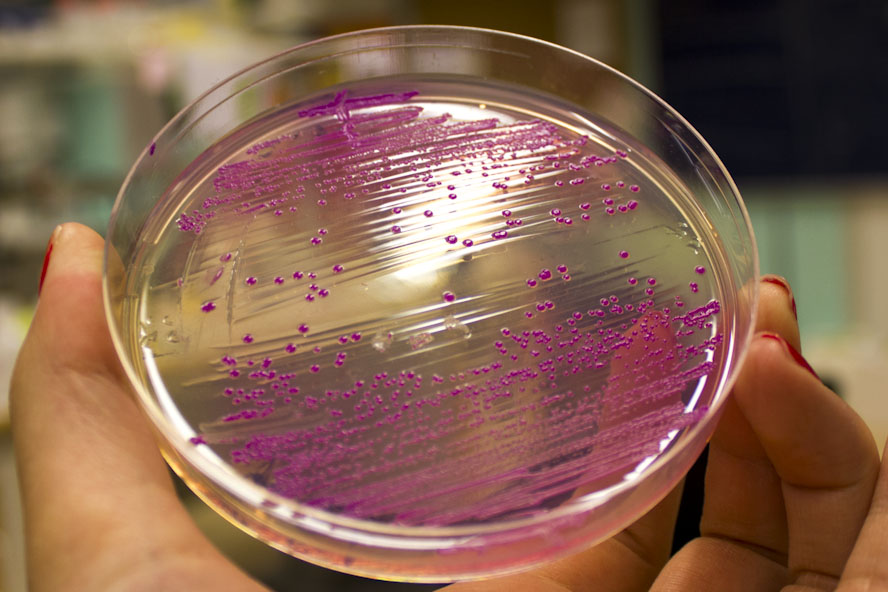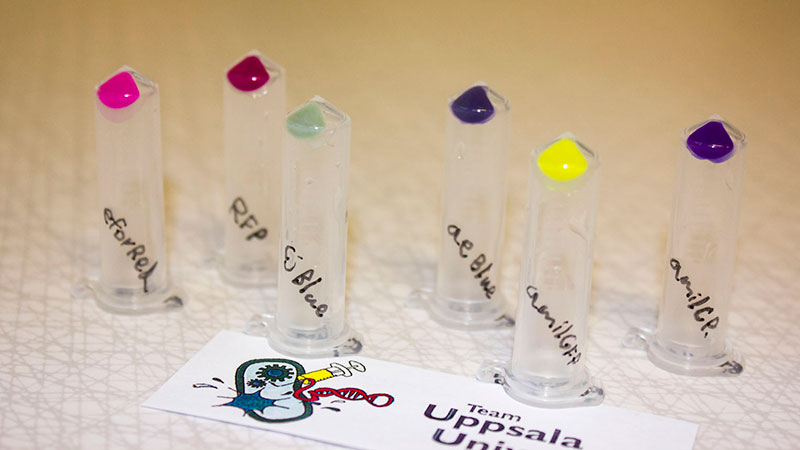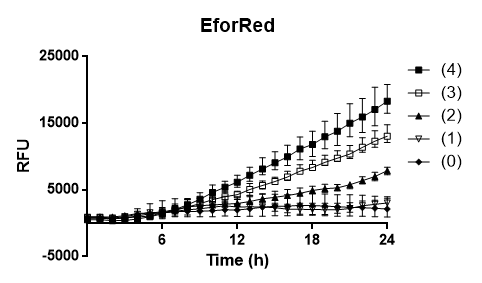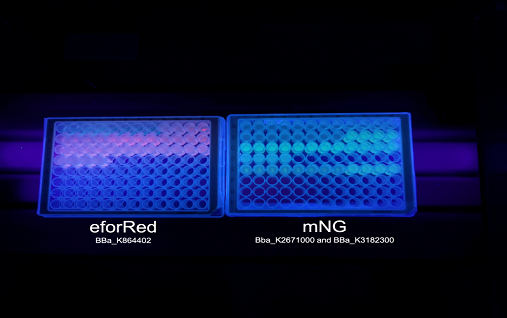Difference between revisions of "Part:BBa K864402"
(→Contribution) |
(→Contribution) |
||
| Line 58: | Line 58: | ||
<br><br> | <br><br> | ||
A study of the molecular weight of p.Cons-eforRed expressed in E.coli BL21 (DE3) gold cells was done by sonicating the cells and then performing a SDS-PAGE electrophoresis on the lysate (<b>Figure 4.</b>) with Biorads "Precision Plus Protein Dual Color Standards" as the protein ladder.<br><br> | A study of the molecular weight of p.Cons-eforRed expressed in E.coli BL21 (DE3) gold cells was done by sonicating the cells and then performing a SDS-PAGE electrophoresis on the lysate (<b>Figure 4.</b>) with Biorads "Precision Plus Protein Dual Color Standards" as the protein ladder.<br><br> | ||
| − | </html>[[Image:T--Linkoping_Sweden--eforred_SDS-page.png|100px|thumb|left|<<div class="figurtext"style=font-size:80%;><b><i>Figure 4.</b> SDS-page of sonicated e.Coli BL21(DE3) lysate with p.Cons-eforRed. Biorads "Precision Plus Protein Dual Color Standards" was used as the protein ladder. The visible band on the gel lies between 25 and 37 kD which correspond to the molecular weight of eforRed which is 26.1 kDa.</i> | + | </html>[[Image:T--Linkoping_Sweden--eforred_SDS-page.png|100px|thumb|left|<<div class="figurtext"style=font-size:80%;><b><i>Figure 4.</I></b> <I>SDS-page of sonicated e.Coli BL21(DE3) lysate with p.Cons-eforRed. Biorads "Precision Plus Protein Dual Color Standards" was used as the protein ladder. The visible band on the gel lies between 25 and 37 kD which correspond to the molecular weight of eforRed which is 26.1 kDa.</i> |
</div>]] <html></html> | </div>]] <html></html> | ||
<br><br><br><br><br><br><br><br><br><br><br><br><br><br><br><br><br><br><br><br><br><br><br><br><br><br><br><br><br><br><br><br><br><br><br><br><br><br><br><br> | <br><br><br><br><br><br><br><br><br><br><br><br><br><br><br><br><br><br><br><br><br><br><br><br><br><br><br><br><br><br><br><br><br><br><br><br><br><br><br><br> | ||
Revision as of 12:36, 15 October 2019
J23110-B0034-eforRed
eforRed eforRed is previously described as BBa_K592012. We submitted a functionally active variant with J23110 and B0034.
Contribution
Group: Linkoping_Sweden iGEM 2019
Author: Andreas Holmqvist and Leo Juhlin
Summary:
In this contribution we characterized the visual absorbance and the fluorescence of this construct. We also tested the oxygen dependency of the chromophore protein expression in E.coli BL21(DE3) cells and then measured the absorbance of the cells with a plate reader.
Documentation:
- the BBa_B0034 ribosome binding site
- the BBa_J23110 Constitutive promotor
To verify eforReds absorbance and emission, the construct was expressed in E.coli BL21 (DE3) gold cells. The bacteria containing the constitutive promotor (p.Cons) was compared to a negative control (Figure 1, left side). Thereafter the eforRed bacteria was centrifuged which displayed a pink pellet (Figure 1, top-right corner). To demonstrate the fluorescence of eforRed, the pellet was placed on a UV-table emitting a wavelength of 302 nm, (Figure 1, down-right corner), which exhibited a pink glowing colour.
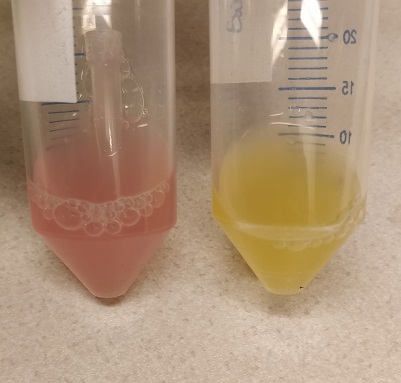
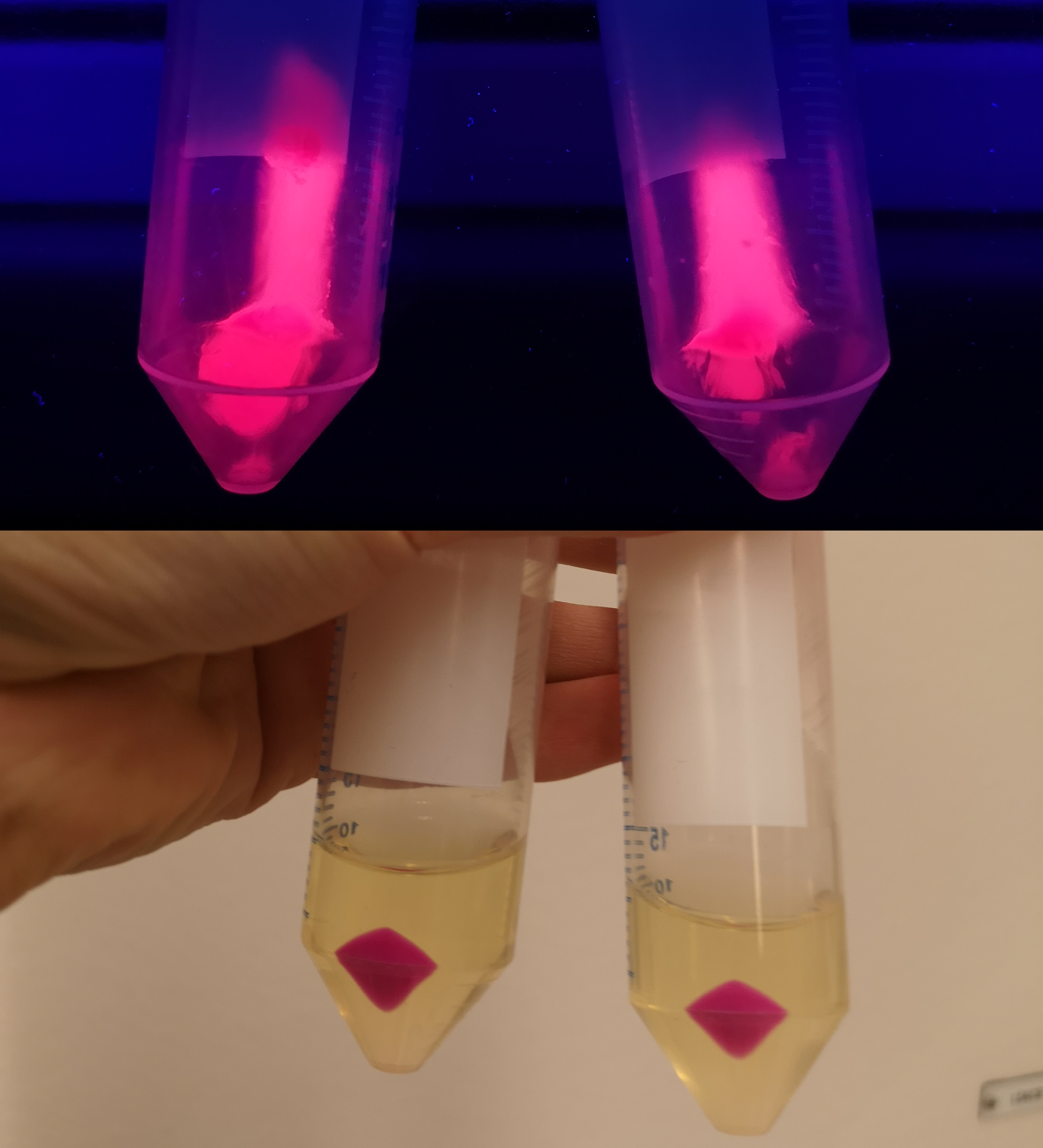
Further characterization was performed in order to demonstrate the absorbance and fluorescence of E.coli BL21 (DE3) gold cells containing p.Cons eforRed were spread on an agar plate containing 25 µg/ml chloramphenicol. The plate was then photographed in visual light and on a UV-table emitting 302 nm (Figure 2 ). The results were the same as above, in visual light (Figure 2, right) the cultures had a burgundy color and on the UV-table the bacteria exhibited a pink glowing colour ( Figure 2, left).
To test the oxygen dependency of the protein production of eforRed in E.coli BL21 (DE3) gold cells, a platereading was conducted. The oxygen access was varied by piercing different numbers of holes in the plastic film of the 96-well plate. The experiment showed that the access to oxygen effects E.colis protein production of eforRed.
A study of the molecular weight of p.Cons-eforRed expressed in E.coli BL21 (DE3) gold cells was done by sonicating the cells and then performing a SDS-PAGE electrophoresis on the lysate (Figure 4.) with Biorads "Precision Plus Protein Dual Color Standards" as the protein ladder.
Usage and Biology
Sequence and Features
- 10COMPATIBLE WITH RFC[10]
- 12INCOMPATIBLE WITH RFC[12]Illegal NheI site found at 7
Illegal NheI site found at 30 - 21COMPATIBLE WITH RFC[21]
- 23COMPATIBLE WITH RFC[23]
- 25COMPATIBLE WITH RFC[25]
- 1000COMPATIBLE WITH RFC[1000]
Note: This part did not have a reference sequence. A reference sequence has since been added based on the part's documentation; a composite part using the following basic parts: No part name specified with partinfo tag. - BBa_B0034 - BBa_K592012- iGEM HQ

